Themed collection Nitrogen Ligands

Introduction to the Nitrogen Ligands Themed Issue
From the 6th EuCheMS Conference on Nitrogen Ligands (Beaune 2015) to an NJC themed issue.
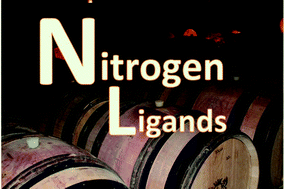
New J. Chem., 2016,40, 5643-5643
https://doi.org/10.1039/C6NJ90028C
Development of porphyrin syntheses
Personal historical comments relating to the advancement of porphyrin syntheses using monopyrroles, dipyrroles, and open-chain tetrapyrroles are presented.
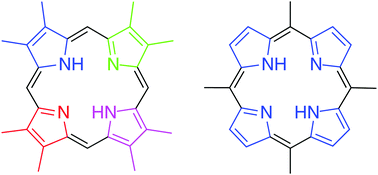
New J. Chem., 2016,40, 5644-5649
https://doi.org/10.1039/C6NJ00820H
Recent advances in catalytic CO2 reduction by organometal complexes anchored on modified electrodes
A critical overview of the very recent literature on heterogeneous electrochemical catalysis of CO2 reduction with organic metal modified electrodes is summarized by taking into account different functionalization methods.
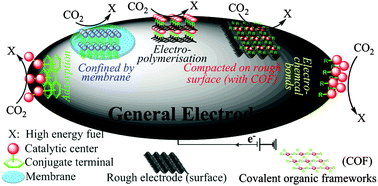
New J. Chem., 2016,40, 5656-5661
https://doi.org/10.1039/C5NJ03426D
Compartmentalized vs. non-compartmentalized translocations in metal porphyrin complexes
Strapped porphyrin ligands exhibit instantaneous and easy-to-control formation of various bimetallic species featuring new coordination modes and dynamics.
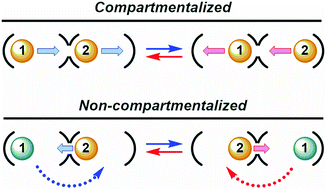
New J. Chem., 2016,40, 5650-5655
https://doi.org/10.1039/C5NJ03120F
Selective complexation of di-n-hexylammonium salts by tailed porphyrin host
A di-n-hexylammonium ion was selectively encapsulated in the cavity of tailed porphyrins due to induced fit and lipophilic interactions.

New J. Chem., 2016,40, 5679-5682
https://doi.org/10.1039/C6NJ00045B
Boron templated synthesis of a BODIPY analogue from a phthalocyanine precursor
The synthesis of aza(dibenzopyrro)methenes (ADBMs) using aryl boron compounds as templates is described. Compounds (1–3) are structurally related to the BODIPYs and were isolated with terminal imine, oxo, or mixed imine-oxo groups. Compounds 1–3 were investigated for their absorption/emission properties, and were probed by DFT and TDDFT methods.
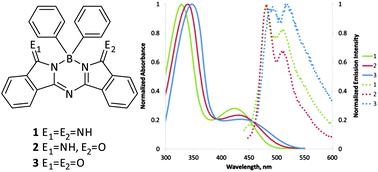
New J. Chem., 2016,40, 5675-5678
https://doi.org/10.1039/C6NJ00085A
A water molecule in the interior of a 1H-pyrazole Cu2+ metallocage
A pyrazole aza-macrocyclic Cu2+ metallocage shows the inclusion of a water molecule not hydrogen bonded with any acceptor or donor groups of the cage.
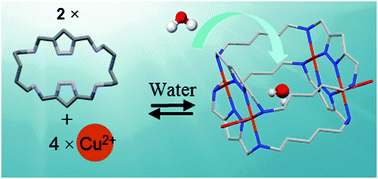
New J. Chem., 2016,40, 5670-5674
https://doi.org/10.1039/C5NJ03234B
The synthesis of flexible tetrapyridylethanes from pyridylpyrylium dications
Novel tetrapyridylethanes and bis-phenylpyridylmethylenepyrans as potential ligands for coordination chemistry.
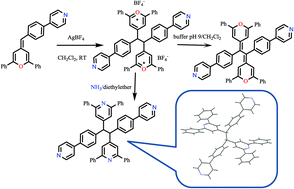
New J. Chem., 2016,40, 5666-5669
https://doi.org/10.1039/C5NJ03257A
The interaction of a β-fused isoindoline–porphyrin conjugate with nucleic acids
The intercalation of a diiminoisoindoline–porphyrin conjugate into the poly(dG–dC) double helix occurs by inducing the fast formation of the helix with temperature.
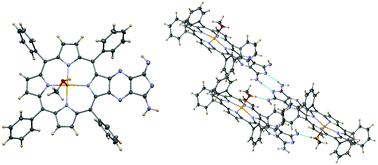
New J. Chem., 2016,40, 5662-5665
https://doi.org/10.1039/C5NJ03201F
Synthesis and photophysical characteristics of 2,3,12,13-tetraalkylbacteriochlorins
Tetraalkylbacteriochlorins, available upon acid-mediated self-condensation of α-ester stabilized dihydrodipyrrin-carboxaldehydes, provide valuable models of the naturally occurring bacteriochlorophylls.
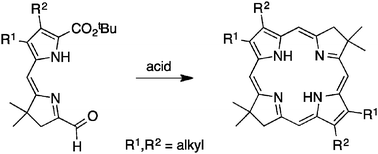
New J. Chem., 2016,40, 5942-5956
https://doi.org/10.1039/C6NJ00517A
Deciphering the CHEF-PET-ESIPT liaison mechanism in a Zn2+ chemosensor and its applications in cell imaging study
Proper fusion of fluorescence mechanisms in a single fluorophore unit is highly desirable to obtain better sensitivity, as well as selectivity towards a particular metal ion.
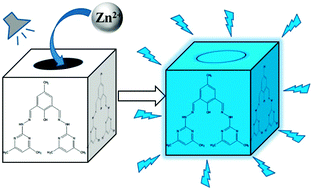
New J. Chem., 2016,40, 5976-5984
https://doi.org/10.1039/C6NJ00234J
Crystal structures, topological analysis and luminescence properties of three coordination polymers based on a semi-rigid ligand and N-donor ligand linkers
Three new mixed-ligand coordination polymers have been synthesized based on 3,3′-(anthracene-9,10-diyl)diacrylate acid and different N-donor ligands. Complex 2 displays rapid and selective sensing of Fe3+.
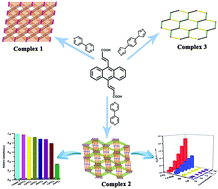
New J. Chem., 2016,40, 5957-5965
https://doi.org/10.1039/C6NJ00180G
Synthesis, structure and properties of thiophene-fused BODIPYs and azaBODIPYs as near-infrared agents
Annulation of thiophene to the BODIPY/aza-BODIPY core showed a significant impact on the spectral properties of the resulting scaffolds.
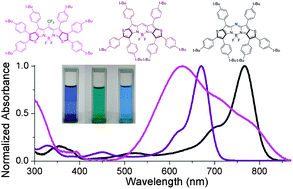
New J. Chem., 2016,40, 5966-5975
https://doi.org/10.1039/C6NJ01011C
Two new bulky substituted Zn porphyrins bearing carboxylate anchoring groups as promising dyes for DSSCs
Two novel zinc-metallated porphyrins, bearing three and six long alkoxy chains at the periphery, have been synthesized as sensitizers in DSSCs.
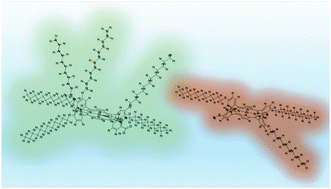
New J. Chem., 2016,40, 5930-5941
https://doi.org/10.1039/C6NJ00634E
Efficient preparation of multimetallic ONO-based Schiff base complexes of nickel(II) and copper(II)
Spectroscopy, structures, electrochemical behavior and magnetic properties of a series of readily prepared [(R-ONO)M(μ-4,4′-bipy)M(R-ONO)] complexes (R = anisyl or ferrocenyl; M = Ni, Cu) have been explored.
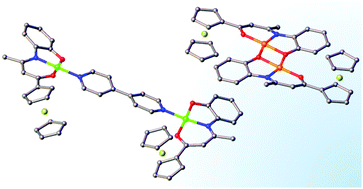
New J. Chem., 2016,40, 5920-5929
https://doi.org/10.1039/C6NJ00932H
DNA structure-specific sensitization of a metalloporphyrin leads to an efficient in vitro quadruplex detection molecular tool
The palladated porphyrin Pd·TEGPy is an efficient turn-on, quadruplex-selective fluorophore thanks to peculiar supramolecular and electronic properties that results in a unique DNA structure-specific sensitization mechanism.

New J. Chem., 2016,40, 5683-5689
https://doi.org/10.1039/C6NJ01012A
Topology of metallacalix[4]arenes with uracil and cytosine ligands: favorable and unfavorable assemblies
A single isomer of many topologically possible ones! The experimentally isolated metallacalix[4]arenes based on pyrimidine nucleobases are the energetically more favorable.
![Graphical abstract: Topology of metallacalix[4]arenes with uracil and cytosine ligands: favorable and unfavorable assemblies](/en/Image/Get?imageInfo.ImageType=GA&imageInfo.ImageIdentifier.ManuscriptID=C6NJ00772D&imageInfo.ImageIdentifier.Year=2016)
New J. Chem., 2016,40, 5914-5919
https://doi.org/10.1039/C6NJ00772D
Heteroleptic Cu(II)–polypyridyl complexes as photonucleases
Four new copper(II)–polypyridyl complexes having tail groups with increasing aromaticity, hydrophobicity and planarity are synthesized. These complexes are found to be avid DNA binders and show efficient nuclease activity under either chemical stimulus or UV-A light irradiation.
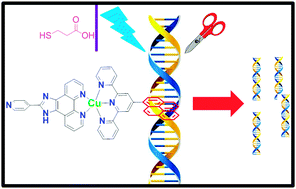
New J. Chem., 2016,40, 5906-5913
https://doi.org/10.1039/C6NJ00409A
Effects of N,N-heterocyclic ligands on the in vitro cytotoxicity and DNA interactions of copper(II) chloride complexes from amidino-O-methylurea ligands
Four novel copper(II) complexes based on guanidine derivatives have been synthesized by addition of N,N-heterocyclic ligands, and their interesting biological activities have been evaluated.
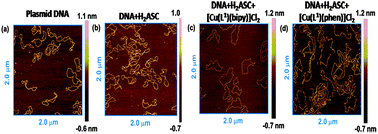
New J. Chem., 2016,40, 5861-5876
https://doi.org/10.1039/C5NJ03439F
Design, synthesis and relaxation studies of triazole linked gadolinium(III)–DO3A-BT-bistriazaspirodecanone as a potential MRI contrast agent
Novel and facile synthesis of a triazole based bisconjugated triazaspirodecanone as a potential MRI contrast agent.
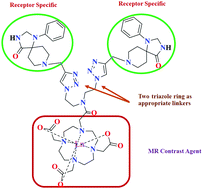
New J. Chem., 2016,40, 5846-5854
https://doi.org/10.1039/C5NJ03220B
Coordination compounds of a hydrazone derivative with Co(III), Ni(II), Cu(II) and Zn(II): synthesis, characterization, reactivity assessment and biological evaluation
Increasing inhibitory effect of Zn-Hp2DAP < Hp2DAP < Co-Hp2DAP on ABC transporter MDR1 drug efflux pump.
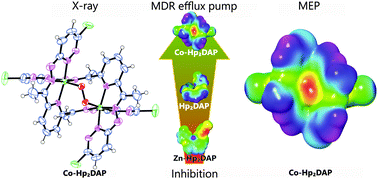
New J. Chem., 2016,40, 5885-5895
https://doi.org/10.1039/C6NJ00560H
Copper(II) complexes with phosphorylated 1,10-phenanthrolines: from molecules to infinite supramolecular arrays
Supramolecular architectures based on copper(II) complexes with diethoxyphosphoryl substituted 1,10-phenanthrolines are reported.
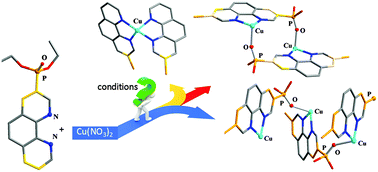
New J. Chem., 2016,40, 5896-5905
https://doi.org/10.1039/C5NJ03572D
2,4 and 2,5-bis(benzooxazol-2′-yl)hydroquinone (DHBO) and their borate complexes: synthesis and optical properties
2,4 and 2,5-bis(benzooxazol-2′-yl)hydroquinone (DHBO) scaffolds show fluorescence stemming from an ESIPT process but also act as chelates toward boron fragments.

New J. Chem., 2016,40, 5877-5884
https://doi.org/10.1039/C6NJ00113K
Effects of five membered aromatic heterocycles at the meso-position on the electronic properties of 3-pyrrolyl BODIPY
The synthesis, structures and properties of 3-pyrrolyl BODIPYs containing five membered aromatic heterocycles such as pyrrole, thiophene and furan at the meso-position are described.
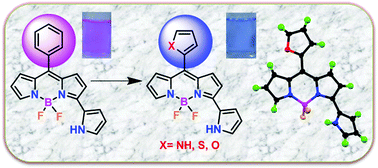
New J. Chem., 2016,40, 5855-5860
https://doi.org/10.1039/C6NJ00118A
Reinforced cyclam derivatives functionalized on the bridging unit
The introduction of one or two nitriles on the bridge of reinforced cyclams paves the way for the synthesis of new bifunctional chelating agents. X-ray structures of the chelators and of two copper complexes are reported.
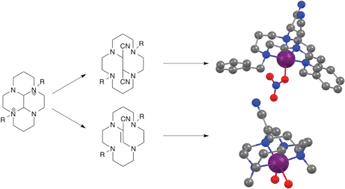
New J. Chem., 2016,40, 5829-5834
https://doi.org/10.1039/C5NJ03488D
The first example of cofacial bis(dipyrrins)
Two series of cofacial bis(dipyrrins) were prepared and their photophysical properties as well as their bimolecular fluorescence quenching with C60 were investigated.
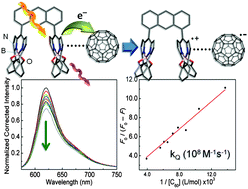
New J. Chem., 2016,40, 5835-5845
https://doi.org/10.1039/C5NJ03347K
Oxaazamacrocycles incorporating the quinoline moiety: synthesis and the study of their binding properties towards metal cations
Nitrogen- and oxygen-containing macrocycles with an endocyclic quinoline moiety synthesized via Pd(0)-catalyzed amination were found to be prospective fluorescent chemosensors for Cu(II).

New J. Chem., 2016,40, 5818-5828
https://doi.org/10.1039/C5NJ03231H
C,N-Chelated organotin(IV) azides: synthesis, structure and use within click chemistry
Novel organotin(IV) azides were employed as building blocks to prepare various organotin(IV) tetrazolides or triazolides.

New J. Chem., 2016,40, 5808-5817
https://doi.org/10.1039/C5NJ03187G
Photophysical and photochemical studies of tricarbonyl rhenium(I) N-heterocyclic carbene complexes containing azide and triazolate ligands
Rhenium NHC complexes bound to azide anions readily react with alkynes to form the corresponding triazolate complexes, a new class of photochemically active species.
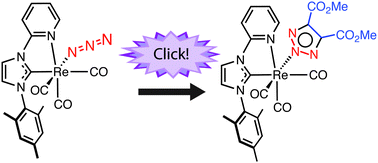
New J. Chem., 2016,40, 5797-5807
https://doi.org/10.1039/C5NJ03301B
Synthesis of heteroleptic terpyridyl complexes of Fe(II) and Ru(II): optical and electrochemical studies
Heteroleptic terpyridyl complexes of Fe(II) and Ru(II) are synthesized. They are characterized using complimentary techniques and their optical and electrochemical properties are studied. A detailed computational study was also performed.
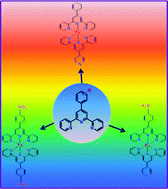
New J. Chem., 2016,40, 5775-5781
https://doi.org/10.1039/C5NJ03106K
Synthesis and spectroscopic properties of β,β′-dibenzo-3,5,8-triaryl-BODIPYs
A series of symmetric and unsymmetric β,β′-dibenzo-3,5,8-triaryl-BODIPYs were synthesized and their spectroscopic properties were evaluated and compared.
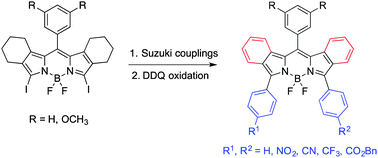
New J. Chem., 2016,40, 5740-5751
https://doi.org/10.1039/C5NJ03324A
Synthesis and spectroscopic properties of novel N–N linked bis-(diphenylboron) complexes
Novel five-membered-ring and six-membered-ring bis-(diphenylboron) complexes are reported.
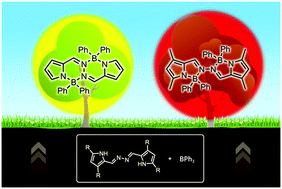
New J. Chem., 2016,40, 5752-5757
https://doi.org/10.1039/C5NJ03217B
Influence of steric hindrance on the molecular packing and the anchoring of quinonoid zwitterions on gold surfaces
The N-substituent on quinonoid zwitterions influences the molecules packing and impacts their anchoring on gold surfaces.
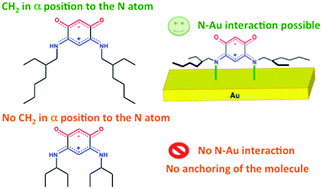
New J. Chem., 2016,40, 5782-5796
https://doi.org/10.1039/C5NJ03251B
On the synthesis of functionalized porphyrins and porphyrin conjugates via β-aminoporphyrins
A two-step methodology to prepare a series of meso-tetraarylporphyrin conjugates bearing water-soluble moieties, anchoring groups and receptor subunits.

New J. Chem., 2016,40, 5758-5774
https://doi.org/10.1039/C5NJ03247D
A bistren cryptand with a remote thioether function: Cu(II) complexation in solution and on the surface of gold nanostars
A di-copper(II) complex is formed in a bis-tren cage featuring a thioether function, capable of grafting on a monolayer of gold nanostars.

New J. Chem., 2016,40, 5722-5730
https://doi.org/10.1039/C5NJ03175C
Synthesis and structural chemistry of bicyclic hexaaza-dithia macrocycles containing pendant donor groups
An efficient medium-scale synthesis and the structural characterization of a series of macrobicyclic hexaaza-dithia macrocycles with pendant donor arms is presented.
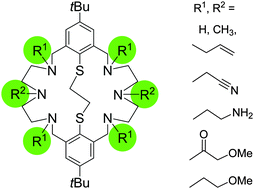
New J. Chem., 2016,40, 5731-5739
https://doi.org/10.1039/C5NJ03197D
Ternary assemblies comprising metal–salophen complexes and 4,4′-bipyridine
The formation of ternary species containing zinc or uranyl–salophen complexes has been explored and analyzed in this work.
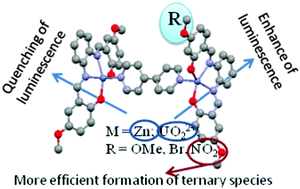
New J. Chem., 2016,40, 5714-5721
https://doi.org/10.1039/C5NJ03210E
Synthesis and characterization of simple cost-effective trans-A2BC porphyrins with various donor groups for dye-sensitized solar cells
Zn(II) porphyrin dyes have been synthesized in three steps and exhibited power conversion efficiencies of 2.1 to 4.2% which depend on the electron donating ability of the R group.
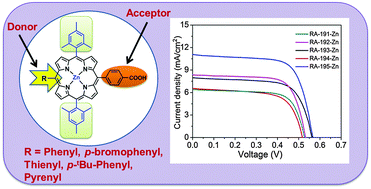
New J. Chem., 2016,40, 5704-5713
https://doi.org/10.1039/C5NJ02610E
Group 9 and 10 complexes with the bidentate di(1H-indazol-1-yl)methane and di(2H-indazol-2-yl)methane ligands: synthesis and structural characterization
Ni, Pd and Co bis(indazol-1-yl)methane complexes assemble into 3D-networks based on intermolecular electrostatic, H-bonds and aromatic interactions.
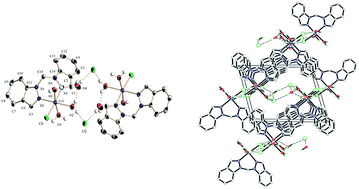
New J. Chem., 2016,40, 5695-5703
https://doi.org/10.1039/C5NJ03135D
RAPTA-C incorporation and controlled delivery from MIL-100(Fe) nanoparticles
The properties of MIL-100(Fe) nanoparticles as vehicles of a non-conventional half-sandwich ruthenium(II) metallodrug in simulated intravenous conditions have been investigated.
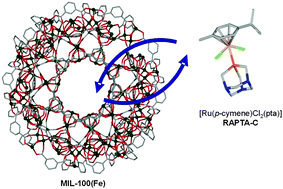
New J. Chem., 2016,40, 5690-5694
https://doi.org/10.1039/C5NJ02741A
Four cobalt(II) complexes based on a new tricarboxylate with a naphthalene ring and different N-containing ligands: synthesis, crystal structures and magnetic properties
Four cobalt(II) coordination polymers have been synthesized under hydrothermal conditions, and their magnetic behaviors have been discussed in detail.
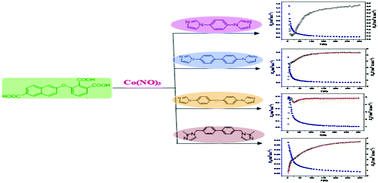
New J. Chem., 2016,40, 5010-5018
https://doi.org/10.1039/C6NJ00065G
Copper immobilized ferromagnetic nanoparticle triazine dendrimer (FMNP@TD–Cu(II))-catalyzed regioselective synthesis of 1,4-disubstituted 1,2,3-triazoles
The synthesis, characterisation and catalytic activity of FMNP@TD–Cu(II) for the synthesis of 1,4-disubstituted 1,2,3-triazoles are reported.
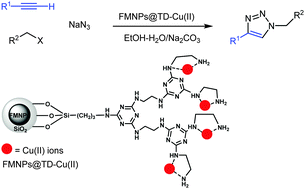
New J. Chem., 2016,40, 3447-3455
https://doi.org/10.1039/C5NJ03219A
New organometallic Schiff-base copper complexes as efficient “click” reaction precatalysts
In the presence of sodium ascorbate, recyclable CuAAC precatalysts displayed high activity allowing the synthesis of a wide variety of 1,4-disubstituted 1,2,3-triazoles in high isolated yields.
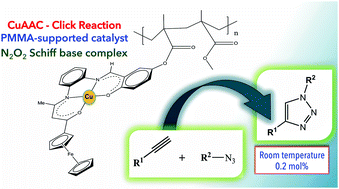
New J. Chem., 2016,40, 3308-3313
https://doi.org/10.1039/C5NJ02681D
Highly selective colorimetric and fluorescent BODIPY dyes for sensing of cysteine and/or homocysteine
Selective “naked eye” and fluorescent sensing of biothiols by visible-light excitable α- and β-formyl BODIPYs 1 and 3 was developed.
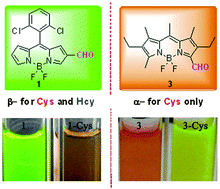
New J. Chem., 2016,40, 1387-1395
https://doi.org/10.1039/C5NJ02346G
About this collection
This themed issue of the New Journal of Chemistry reports recent advances in the chemistry of nitrogen ligands, including organic, coordination, metal-organic and bioinorganic chemistry, and also materials science and catalysis.